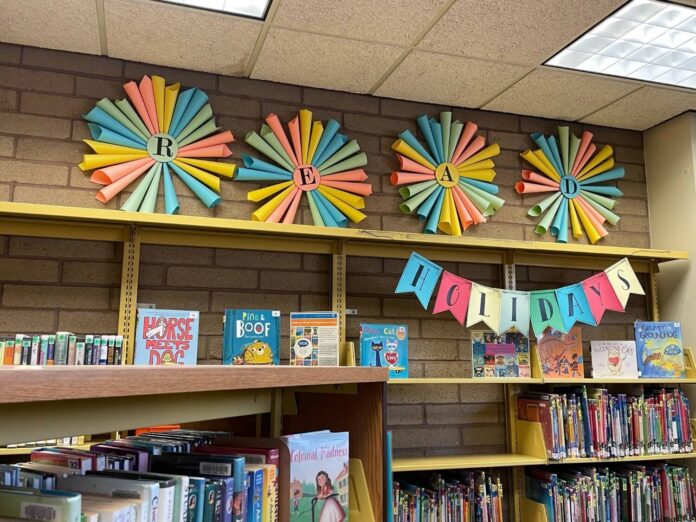
As local schools let out for the day, Eagle Rock Public Library (ERPL) begins to fill with students, and the space takes on a low buzz of energy. Kids wander the stacks, use the computers or sit in groups doing homework. Some find Young Adult Librarian Patsy Tuck at the help desk and ask for directions to “Seige and Storm,” “Looniverse” books or “Frozen.” The library is still getting back into the swing of in-person operation, but already it has regained the animation and lively-though-quiet chatter of a community center.
As per the Los Angeles Public Library (LAPL) mission — to enrich, educate and empower LA’s diverse communities through access to ideas, books and technology — EAPL is rooted in community. Library programming reflects the input of community members through the library leadership program, Tuck said.
According to Children’s Librarian Caitlin Quinn, ERPL physically re-opened in June of 2021. Throughout the pandemic, the library has continued to serve its community through virtual programming, which continues even as in-person operations have resumed.
“Even though we were closed physically our virtual doors were open,” Tuck said.
The library regularly serves kids from the surrounding schools, including St. Dominic’s School, Dalia Heights Elementary School and Eagle Rock Middle School, High School and Elementary School, Quinn said. In addition to helping students with their homework, the library offers virtual programs that span everything from learning to draw to tarot card reading, according to Tuck.
In the library’s Teens Leading Change program, young adults explore subjects of interest and create projects to enact positive change in their communities, Tuck said.
Before the presidential election in November 2020, teens from the branch worked in conjunction with the League of Women Voters on a project about voting rights, which culminated in an event going over ballot measures to help inform local voters, according to Tuck.
“We got derailed by COVID when that happened so we had to change and pivot, but they were able to see through the project,” Tuck said.
Despite pandemic-related obstacles, the ballot event had one of the highest attendances in all of LAPL streaming, according to Tuck. She said it was very rewarding to complete such an important project.
According to Tuck, the branch also draws young adults through the Teen Council, a group involved in library leadership. Tuck said the library recently received a grant for a designated area for teens and is currently in the process of designing the space with input from the council. Tuck recently placed the order for the furniture, and said she hopes to have it set up in February.
Additionally, the ERPL is a branch of the The Neighborhood Science Program, which aims to involve kids in STEM, with a focus on the environment. Through the program, teens and children can check out kits with environment-related education projects — like air- or water-quality testing materials, and use them alongside programming.
To foster community engagement in younger children, the library also hosts a monthly Social Justice Book Club. Quinn, leader of the book club, said she was inspired to start it because of both national events and reflective changes happening in the publishing world. Quinn noticed children’s authors beginning to tackle major social issues — Deferred Action for Childhood Arrivals (DACA), white privilege and equity versus equality.
“It was just an exciting moment where I felt like yes, books are such a great point of conversation — a starting point, to jump in and start talking about these things,” Quinn said. “I don’t think that kids are ever too young to engage.”
Sonja Hannah, the ERPL branch manager, said the program provides both children and their parents with a supportive space to talk about serious issues, which parents may be unsure how — or whether — to broach.
“You’re not going to be able to shelter your children, so it’s best to educate, and learn with them,” Hannah said.
Although many of the library’s programs have seen a decline in engagement since going online, the new platform has also allowed for greater flexibility and accessibility. With the Tech2go program through the LAPL, ERPL community members are able to borrow laptops and internet hotspots for long-term use. Now it’s easier than ever to access programs from across all library branches, according to Hannah.
“The best thing about the virtual [programs] is that they’re accessible now—at least for those that have the technology,” Hannah said. “And now we’ll even give you the device to access it.”
Community member Paula Martinet recalls taking her children, now 24 and 27, to ERPL when they were young.
“I took pictures of them right in front of the sign. It was a proud moment when they got their cards,” Martinet said.
Nowadays, Martinet said she uses the branch almost weekly to research the diverse subjects that interest her. Last week, she read books on Qigong, and this week she is reading collections by Irish poets.
The ERPL has not been deterred from pursuing its mission of community education through access to books and ideas, according to Caitlin. Coming through the other side of pandemic closures, the place itself maintains its longtime hold as a center of community learning.
![]()


































